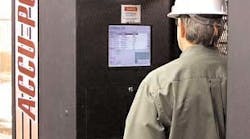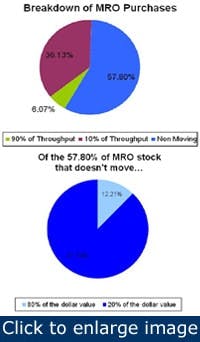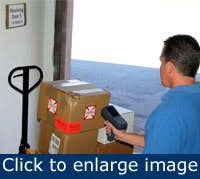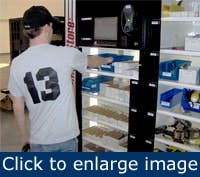By now, most plant maintenance professionals know that enlightened MRO inventory management can cut costs, improve machine availability and boost maintenance productivity. But even those who realize they might be sitting on a gold mine of excess and obsolete parts and supplies, needless stock-outs, and wasted activity often don’t understand how easily they might harness the expertise, services and technologies of their existing supplier base to improve the situation.
A veritable army of experts is eager to help you rationalize inventory, reallocate or sell off unneeded items, automate and add intelligence to procurement, and put critical items closer to the right set of fingertips.
We spoke with part and supply vendors and distributors who are willing to invest their time and share their expertise for nothing more than the hope you’ll become a new, bigger and more committed customer. The sophisticated systems they recommend might have much shorter paybacks than you thought. And liquidating your excess stock could bring cash that’s especially handy in these uncertain times.
The experts’ advice adds up to four steps that can raise cash, improve overall equipment effectiveness (OEE) and help optimize wrench time while bringing your inventory management system into conformance with 21st century best practices.
Identify surplus inventory
Arguably the most difficult step is to identify surplus inventory. It’s not as though you don’t know you have surplus material. “Companies of all sizes come to us to see if we can help them stock what they need,” says Kevin Hartler, director, U.S. solutions development, Grainger Industrial Supply (www.grainger.com/inventory). “We surveyed the customers we counsel and 73% believe they have too much inventory, 87% see a substantial cost-saving opportunity in MRO inventory and 71% say they could improve inventory management.”
Figure 1: Only 6% of typical MRO inventory makes up 90% of throughput and 58% essentially doesn’t move. Typically, 80% of the value is concentrated in 12% of this stagnant inventory. (EquipNet)
The average turnover of MRO inventory is a year or more, so at least half of it is commonly considered inactive. Only 6% of typical MRO inventory makes up 90% of throughput and 58% essentially doesn’t move (Figure 1), according to reallocation and liquidation company EquipNet (www.equipnet.com). Typically, 80% of the value is concentrated in only 12% of this stagnant inventory.
You might defend your “inactive” inventory as critical components with long lead times, seldom needed, but when they are, production can’t wait. And some of them are, but many aren’t. “We classify items as critical, fast, slow, or inactive,” says Hartler. “Critical items might not move, and that’s OK, but what is critical? We help define it.”
Inventories are driven by fear, not experience. “People are afraid of the consequences of a stockout, regardless of whether or not they experience stockouts,” Hartler says. “This fear drives demand and excessive supplies. The key is to understand the needs of the facility, not the individuals, and use the facility’s requirements to generate demand and manage supply.”
Stores are kept for convenience and insurance, but tend to be hoarded and piled up. “We find it in every crack and seam, in desk drawers and unmarked cabinets in distant recesses of the facility,” Hartler adds.
Even the best organized inventory costs a lot of time to place orders, receive, put away, cycle count and issue. “It takes an average of 90 minutes to replenish an item,” says Hartler. It also takes up floor space, cabinets, bins and racks.
Suppliers can help you baseline your facility and recommend management strategies and methods. Data such as usage, issuances, quantities and frequencies drives decisions about consumption and supply based on the facility’s needs rather than individual fears and preferences.
Fast moving inventory is accessed frequently and should be convenient. It’s a candidate for vending or placement in an area or location where it can be consumed without walking to a central storeroom. Slow moving items might be put in a central location, or left at your distributor’s warehouse until they’re needed.
“Inactive items are candidates for investment recovery through supplier buy-back or auction,” Hartler says. “We can typically take 25% of your inventory off the shelves with immediate savings.”
Reducing inventory levels also cuts carrying costs, says Alan Morris, vice president, business development, A3 Technologies (www.a3-tech.com). “Many people estimate annual inventory carrying costs to be 25 cents for every dollar of inventory.”
Redeploy excess
Companies that recycle, redeploy, resell and reuse their surplus or obsolete materials and equipment return millions of dollars to their corporate treasuries every year, says CAPS Research (www.capsresearch.com). The organization reports that each dollar spent on investment recovery returns $31, based on research sponsored by the Investment Recovery Association.
Along with common recommendations about management support and key performance indicators (KPIs), CAPS says an effective investment recovery program should include:
- Financial incentives for surplus disposition.
- Considering the use of surplus and refurbished assets before purchasing new.
- Early involvement in capital projects ranging from real estate purchases to plant closures.
- Investment recovery supplier integration and support.
- Effective use of technology to support surplus sales or redeployment.
- Effective surplus prevention and return-to-supplier programs.
- Strong external networks to support surplus sales or redeployment.
Once you list your surplus materials, the key is to get the most value. “When a problem has been identified — obsolete spares that don’t move, or equipment left over from a project that didn’t use them all, or was cancelled or stopped — you want to liquidate them at the highest return,” says John Cote, MRO manager, EquipNet.
Market values depend on the nature of the goods. In general, complete units such as a valve bring a higher percentage of their purchase price than parts such as kits, gaskets and O-rings. Commodity items are easier to sell for more return than specialty items.
“If possible, the kits and parts are sold in groups and lots, such as ‘5 Apollo valve kits.’ Larger quantities of commodity items give us more options, such as distributors, dealers, or wholesalers,” says Cote. “Based on our experience, we set values for the inventory, typically 5% to 10% of purchase price for parts, 20% to 40% for complete items.”
After EquipNet and the owner come to an agreement on pricing, commission and expectations, EquipNet loads the inventory into its asset redeployment software and sells the surplus items through its sales, marketing and e-commerce teams. “First, we target end users, who are willing to buy pieces they might not need right now for a good price. For faster sales, we reduce prices,” Cote says. “Many items are sold electronically, as you can see on our Web site. If you use the ‘Make an offer’ button, your offer is routed directly to the seller for their consideration. We also use eBay, but we start with targeted offers. We use a variety of methods to get the highest returns.”
The company offers the same software to companies that want to be able to redeploy assets internally, for example, among multiple facilities. “When a new item is added, the software e-mails the other facility managers to see if they want it,” Cote says “If the company decides they want us to sell an item, we can simply transfer it from their closed intranet to our Internet site.”
Manage the essentials
Once you’ve minimized inventory, it obviously becomes even more important to keep it accurate, accessible, in good condition and fully stocked. “Companies are considering two main aspects in the current economic environment: to have enough cash and to optimize asset utilization,” says Paul Strueven, inventory optimization consultant, Mincom (www.mincom.com). “They need to have enough materials to produce, but also reduce costs and maximize profits. This takes a real understanding of requirements, not just traditional reorder quantities.”
Photos of parts and digital documents can easily become part of an item’s record using inexpensive barcode and paperwork scanners. Imagine you’re at a receiving dock and notice a damaged part. “We can take a picture of the part and move it to QA automatically,” says Alan Morris, vice president, business development, A3 Technologies (www.a3-tech.com).
The picture is associated with the part and the order in the database, and can be forwarded to the supplier for further action. Images of certificates and documents can be saved and associated with an item for authenticity, calibration, etc.
A typical barcode scanner can take the pictures, and a low-cost document imager be used for papers. “If parts arrive with damage or rust, or if they’re the wrong parts or have the wrong coating, you can take a picture of it,” Morris says. “Our clients are always coming up with new ways to use it.”
Strueven says to start with manufacturer recommendations and one or two years of history to determine usage, criticality, cost and stock-out cost. “The software calculates and best-fits the part history to one of about 10 industry-standard algorithms to minimize carrying costs — ordering, stocking, handling, interest, pilferage — which are typically 25% of the inventory costs,” he says. “We typically can save 10%, which can be $2 million or even $5 million, while increasing critical stores.”
Software can allow you to list equipment by criteria, such as items that have moved or not within the past year, items that are associated with particular pieces of equipment or of a specific type. It can tell you what kits have a specific part, or what parts are in a kit. Criticality factors indicate which spares are required for insurance purposes.
Duplicate inventories can be consolidated. For example, “Duct tape might have six names, spellings and storage locations,” Strueven says. “We find, combine and merge those into one.” Similarly, the inventories of multiple warehouses can be brought together so you can see that if you’re out of stock in one, you can get it from another. Parts that are obsolete in one location can be moved to another, where they’ll be used. Seldom-used high-ticket and long-lead items can be kept available in minimum quantities accessible to multiple facilities. “The right amount in the right place,” he says.
Mincom’s typical implementation takes three or four weeks. “We’ll identify 1% to 5% savings during that time,” Strueven says. “Reaching 10% to 20% savings takes a while, because if you have 30,000 items in inventory, you can’t evaluate those every month, but payback is typically less than a year, usually six months.”
OneSteel, Australia’s largest manufacturer of steel long products, used an inventory management system and analytical software to perform complex analyses of vast amounts of raw inventory data and provide meaningful information. “Today, OneSteel has realized a 15% reduction in inventory holding at our Laverton steel site using Mincom’s inventory optimization solution,” says Alan O’Connor, OneSteel’s supply quality and projects officer. “The freeing up of capital and significant inventory reductions have been achieved while ensuring stocks of key spares have been enhanced.”
Plants producing commodities that fluctuate in value can adjust criticality and safety stock based on commodity prices. For example, a copper mine might view more equipment as critical when the price of copper is high. They can adjust inventories based on that factor.
[pullquote]Tying inventory management software into barcode or RFID tags and picking systems helps keep inventories accurate, speeds handling and automates reorders, all helping to hold stocks at minimum quantities. “For example, if you have a 50,000 sq. ft. warehouse and a pick list, where are the items?” asks Morris. “Charlie might know, but he’s off today. We guide the picker to the right places in a methodical way.”
Look at how you’re handling direct materials for inspiration. “Most plant’s attitude about MRO is much different than direct materials,” says Hartler. “They know exactly what’s happening with direct materials. They need to apply that philosophy to MRO.”
Qualify and track vendors for performance, safety, delivery and returns, and consolidate on the best ones to streamline ordering. Be quantitative about mutual expectations and let them know you’re paying attention.
Of course, the real purpose of MRO inventory is to get it off the shelves and use it to make money. But many companies don’t view it that way. “We see three typical scenarios in our appraisals,” says Hartler:
- Stock environment: Materials are kept “just in case,” limited by a budget and managed reactively with the goal being to have stuff.
- Managed environment: Inventory is driven by data and a business program, maybe with vendor management, with the goal of controlling costs.
- Leveraged environment: MRO inventory is an investment with a goal of recovering the investment through usage or sell-back. Here you might see consignment as a strategy.
Put it to work
Increasing wrench time — the portion of technicians’ time performing work as opposed to less productive activities such as walking to or waiting at a crib — often is a significant portion of the payback on inventory management systems. “Many plants get 30% or less wrench time,” says Hartler. “Technicians want to do technician work, but management prevents them by making them walk to storerooms and look for what they need. A storeroom doesn’t need to be like your garage, with everything in one place where you have to go in and find it.”
Figure 2. Atlantic Transportation in Washington, D.C. moved a 12,000 sq.ft. spare parts department into 1,500 sq.ft. by storing 99% of its 100,000 parts in four vertical storage units.
Instead, place inventory where it’s needed and make access quick and easy for technicians — just like it used to be when they hoarded it in their workbenches. “The focus has evolved from getting millions of dollars worth of unmanaged inventory into the crib, to speeding access at the point of use with passive technology that automatically authenticates and lets people just take what they need while we figure out what happened,” says Larry Harper, president, WinWare (www.cribmaster.com). “We’re using RFID, scales and software to put inventory into drawers and cabinets near the operators and technicians.”
RFID enables “passive issues,” says Robert Holmes, marketing director, WinWare. Employees simply get what they need while the storage equipment gathers the digital information required to manage replenishment, do supply chain communication and capture solid management data to make better business decisions. “Passive issue technology like RFID or scales requires less employee compliance, which, in turn, has less of an effect on company culture,” Holmes adds. “This means less time required for training and the savings begin immediately.”
Different situations call for different approaches. Vending machines have limitations on what you can put into a helix, and changes might require reconfiguration of helixes and carousels. RFID and scale systems can overcome those problems and allow faster dispensing and restocking. Employees just identify who they are by means of a password on the touch screen or a bar-code scan (some put their bar codes on their hard hats) then take what they need (Figure 2). If accountability isn’t important, you can configure open shelves with scales and bins to trigger reorder points. Transactions are recorded automatically when inventory is removed from a bin based on the amount of weight that was removed.
Large-scale automated storage and retrieval systems (Figure 3) can save floor space or increase storage capacity, allowing plants to consolidate or combine facilities by packing more into a smaller footprint. Automation software can control access with open and secured trays on the same unit. Some are available to all, some only to managers without a separate area for security.
“Everything is delivered waist-high so there’s no walk-and-search, less strain, fewer injuries and less training for new or temporary employees,” says Ed Romaine, vice president, marketing, Remstar (www.remstar.com). “No more flood of people waiting for what they need.
“ROI of nine to 18 months is typical, by saving the time of well-trained people walking around to find something. Instead, they can log onto a PC in a manufacturing cell to request an item, and it’s ready when they (or a runner) come to get it.”
Software can offer the fastest path to accessing a given set of parts, and pick-to-light capability guides parts pickers by lighting an indicator on the correct location or bin. “These increase productivity and picking accuracy,” says Romaine. “The software also communicates with host systems such as a CMMS to do kitting. It remembers which parts are in kits, so if all of a given part has been allocated to kits, you can still get one by having the software break up a kit.”
Vending machines can keep parts, materials and special tools close to the work. A kit might be a list of items to collect at the time of issue, or preassembled in a single location. “Either way, once the kit information is imported into the software, it can vend the entire kit with a single command,” says Holmes. “A helix machine can spit out the parts.”
Figure 3. Like a hotel mini-bar, vending cabinets with RFID and scales can keep track while technicians freely access tools and materials without slowing down. (Cribmaster)
When tools are stored in vending cabinets (Figure 3), software can track tool returns, sharpening or calibration. “You might have an RFID cabinet with a green side and a red side — you scan the work order to open the cabinet, take the tools and materials from the green side, and return tools to the red side,” Holmes adds. “The software notifies when returns need to be processed and tells what needs to be done.”
The potential for inventory management software combined with barcodes and RFID, automated storage/retrieval and vending systems to help minimize maintenance inventory while improving worker efficiency isn’t just for big companies anymore. “It used to be that larger companies did this on their own with internal resources,” says Harper. “Now, we see companies looking to their distribution base for help. The distribution channels are being more active with their larger accounts.” Distributors resell storage and vending equipment, and refill the inventories in machines using remote management capabilities.
“Payback is usually eight months or less, often four months,” says Holmes.
“It’s a standard part of manufacturing,” Harper says. “If you’re in manufacturing, you have to manage inventory because the savings are there.”




